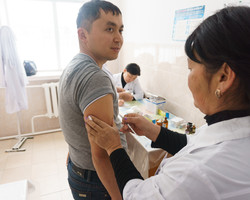Unleashing the potential of vaccines for a healthier Europe

Task Force for Global Health/Ilya Karimdjanov
Compared to every other WHO region, the European Region has the lowest mortality figures for children under the age of 5. The Region has been free from poliomyelitis since 2002, and many Member States have also stopped the endemic spread of measles and rubella.
These incredible achievements would not have been possible without immunization programmes, which ensure vaccines are readily available to prevent the spread of many diseases that could harm people’s health, prosperity and productivity. Individuals who contract vaccine-preventable diseases often suffer not only ill health but also education and economic impacts, as their options and potential can be limited by long-term effects such as severe physical disability.
The full potential of vaccines to strengthen communities and contribute to the Sustainable Development Goals remains untapped. Providing vaccines through the life course means making age-appropriate vaccination available not only to all children but to people of every age. With immunization set out as one of the flagship areas for the European Programme of Work, WHO/Europe is renewing efforts to ensure equitable access to safe and effective vaccines – a vital step towards achieving health and well-being for all.
Minding the gaps
Many countries in the European Region have among the highest rates of routine immunization coverage in the world. For the Region as a whole, over the past 5 years ≥90% of eligible children received their first dose of measles-containing vaccine. Similarly high rates have been reported for several other vaccines in the national immunization schedules.
Nevertheless, from 2017 to 2019, the Region experienced the worst measles outbreaks in over a decade, affecting nearly all countries and peaking at over 100 000 cases in 2019. These and other outbreaks of vaccine-preventable diseases demonstrate that progress in the Region has been fragile, uneven and hence insufficient to protect everyone. Even a small percentage of children missing routine vaccinations each year leads to many people in the Region remaining susceptible over time. Large pockets of susceptible individuals can lead to large outbreaks.
While working to maintain high routine coverage, countries also need to identify and address what is holding back progress. The actions of several countries in the Region have shown that closing immunity gaps requires tailored approaches.
Local solutions to local barriers
When uptake of vaccination against human papillomavirus (HPV) took a downward turn in Denmark in 2014 following negative media reports questioning the safety of the vaccine, health authorities determined why trust in the vaccine was falling and set about to rebuild it. They partnered with civil society groups, initiated a health literacy campaign and proactively reached out to concerned parents. Immunization rates rebounded as trust in the vaccine once again increased, meaning that thousands more young women could be protected against the virus that can lead to cervical cancer.
In Romania, the measles outbreak of 2017 to 2019 affected districts unevenly, reflecting years of disparate coverage among otherwise similar areas. A study of the potential causes of this disparity found differences in the vaccination experience, including how health professionals in each area communicated about vaccines to parents. The results pointed to the need for improved guidance and training for health professionals on how to increase understanding and improve the immunization experience for parents.
Ukraine has significantly improved routine immunization coverage since 2016. However, despite steady progress, it has not yet achieved the target of 95% of children vaccinated against measles and other vaccine-preventable diseases. Promptly addressing the remaining gaps has been especially crucial in the context of the measles outbreak, which resulted in 57 000 reported cases in the country in 2019, and the current COVID-19 pandemic.
With no central registration system for routine vaccinations available in Ukraine until recently, it has been a challenge for authorities to identify, reach and immunize children who have missed out on routine shots. Through good coordination between the health and education sectors, the country initiated verification of children’s immunization status through school-based records. This has made it possible in many cases to identify children at risk and inform immunization catch-up campaigns so they can reach the children before the measles virus does.
2030 European Immunization Agenda
The European Immunization Agenda for the coming decade seeks to ensure that everyone enjoys the full benefits of vaccines throughout their lives no matter who they are, where they live or when they were born. It will be determined by national priorities – a bottom-up approach providing localized solutions to localized issues.
Guided by the principles of the European Programme of Work, the Agenda will be:
- equity-based
- people-focused
- country-owned
- data-enabled
- partnership-based
- innovation- and research-driven, and
- primary health care-based.
To accelerate progress, WHO/Europe will be working closely with Member States and partners to build trust in vaccines, understand and remove barriers to vaccination, strengthen primary health care so routine childhood vaccinations reach every child, and extend programmes to benefit people of all ages. By working together, the Region can harness the potential of vaccines to protect individual health and prosperity as well as broader productivity within society.
Flagship initiatives
The work of WHO/Europe’s vaccine-preventable diseases and immunization programme contributes to one of the 4 flagship initiatives to complement the European Programme of Work, which sets out health priorities for the coming 5 years.
These initiatives – the European Immunization Agenda, Healthy Behaviours: Incorporating Behavioural and Cultural Insights, the Mental Health Coalition, and Empowerment through Digital Health – are intended as accelerators of change. They mobilize action on critical issues that feature prominently on the agendas of Member States and for which high-visibility, high-level political commitment can be transformative.



